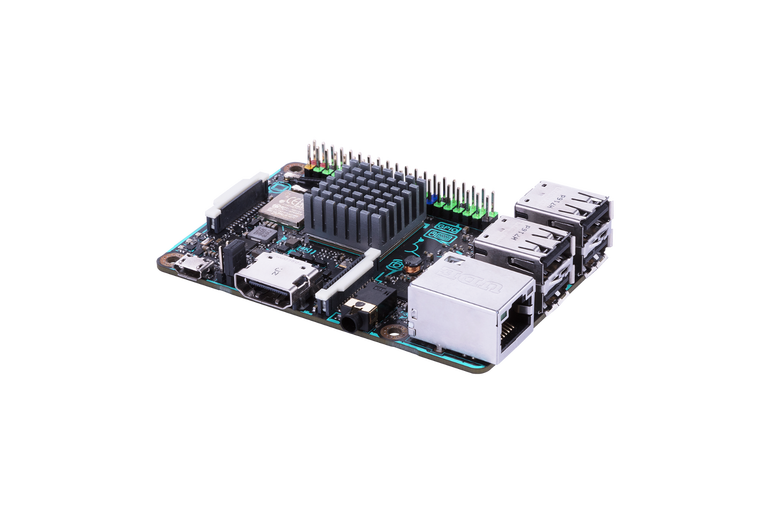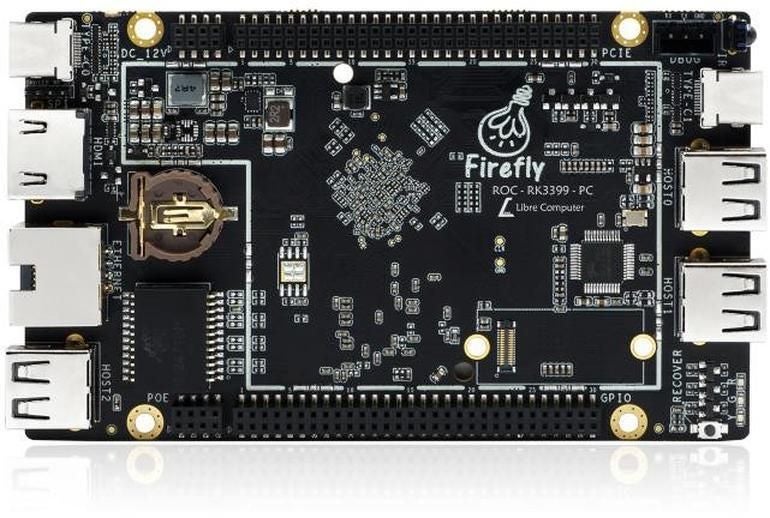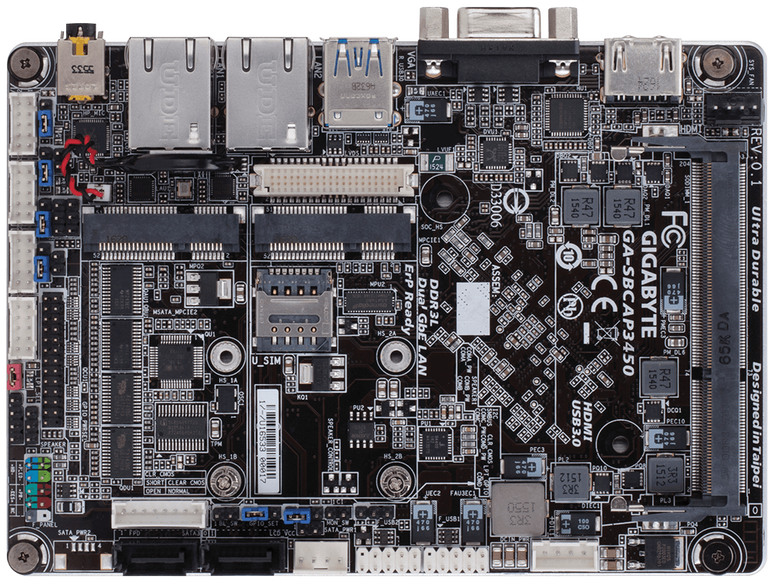Raspberry Pi challengers: The newest boards you can buy
Image 1 of 8


The latest boards
The latest boards
The Raspberry Pi may be the world’s best-selling single-board computer but it is far from the only credit card-sized device available.
While the Pi strikes a fine balance between performance, price and usability, other tiny boards deliver higher specs at a premium price.
In 2018 new boards have brought high-end features to single-board computers: six-core processors, support for 4K displays, fast SSD storage via SATA and M.2 interfaces, and even specialist chips that accelerate machine learning.
However, it’s worth pointing out that few boards are as accessible or offer the same breadth of stable software as the Pi.
Here are notable boards released in 2018 or due out before the year’s end.
This gallery is also available as a single-page article.
NanoPi K1 Plus
What it offers
The NanoPi K1 Plus is less powerful than many other computers in this round-up, and is akin to a Raspberry Pi 3 B+ with a slightly slower CPU and double the memory. The NanoPi K1 Plus is more comparable to the Pi 3 B+, and as such is a machine suited to software and hardware development. However, worse driver and software support than the Pi means this board is probably one for technically savvy users only, who are prepared to devote time and effort getting it up and running.
Specs
The NanoPi uses a 1.3 GHz Allwinner H5 Arm SoC with ARM Mali-450 six-core graphics, 2GB DDR3 of RAM, a Raspberry Pi-compatible 40-pin header for hooking up other electronic hardware, 802.11n Wi-Fi, has a microSD card reader and optional eMMC storage. It also supports gigabit Ethernet, sports three USB 2.0 ports, a 3.5mm audio jack, a DVP camera, and HDMI 1.4.
The board runs a custom version of Ubuntu Core 16.04, which doesn’t boot to a traditional windows desktop but has to be logged into from another machine’s terminal. If you want to use it as a desktop machine, the board supports DietPi, an extremely lightweight version of the Linux-based Debian Jesse OS, as well as the retro-gaming system Lakka. Early users of the board suggest Ubuntu Core works, but that it is difficult to get audio working due to driver difficulties.
Where to buy
The board is available here for $39.
ASUS Tinker Board S
What it offers
A more powerful and fully featured board than the Raspberry Pi, albeit at more than twice the cost, that can serve as a Chromebook-like PC, media center, retro-games console or Android box. It is based on a slightly older chipset than many other boards in this round-up but reviews have found its custom version of Android runs well, with a wide range of working software. The board is also listed as supporting Debian Linux, the Chromium OS variant Flint OS and media center software based on Kodi, among others.
Specs
The Tinker Board S has a quad-core 1.8GHz Rockchip processor, 2GB of DDR3 memory, support for 4k video displays via HDMI, gigabit Ethernet, 192kHz/24-bit audio, 802.11 n Wi-Fi, and a 40-pin header including a power-on pin and enhanced I2S pin with Slave mode.
Where to buy
The board is available to buy here for ~$79.99.
Pine H64
What it offers
A decent machine for the price, on paper at least, with support for 4K displays and targeted at those looking for a new single-board computer to use as a media center.
Specs
The H64 offers an Allwinner H6 SoC with an Arm Cortex A53 processor, a dual-core GPU Mali T-720 GPU, 1/2/3GB of DDR3 memory, a single USB 3.0 port, HDMI 2.0a, and Gigabit Ethernet.
The H64 will support version 4.9 of the Linux kernel, with Pine64 promising it will run a variety of Linux-based operating systems, including Android.
Although early boards made by Pine64 were heavily criticized in some reviews for having such poor software support that some reviewers couldn’t even get a working Linux desktop to boot, reviews of more recent boards indicate improved support.
That said the board’s makers Pine64 say H64 is “still in early-stage development cycle” and “the current board is only suitable for developers and early adopters”.
Where to buy
The $25 board is available to buy here. Although it is currently out of stock, makers Pine64 say a refresh of the H64 is imminent, and that they are planning to introduce a smaller model B version that has the same specs as the model A but lacks the mini-PCIe port.
RockPro64
What it offers
A muscular board with a six-core processor and substantial GPU capable of driving two 4K displays, as well as the ability to hook up fast storage. It is also available with a Neural Network Processor, designed to accelerate the rate at which the board can run trained machine-learning models handling tasks such as image and speech recognition.
Specs
The RockPro64 packs a Rockchip RK3399 SoC with a six-core processor including two Arm Cortex A72 cores at up to 2.0GHz and four Arm Cortex A53 cores, an Arm Mali-T860 MP4 GPU, and 2 – 4GB of LPDDR3 RAM. The ports include a single USB 3.0 and one USB 3.0 type C with DisplayPort support, alongside a PCIe slot for hooking up fast SSD storage, gigabit Ethernet, and HDMI.
While in theory the RockPro64 should run a variety of Linux-based operating systems, including Android, its makers currently class the board being “only suitable for developers and early adopters” due to the early stage in its lifecycle. The board’s predecessor, the Rock64, was found to be reasonably reliable so these issues may be resolved over time.
Where to buy
The board is available here for $59.99.
Renegade Elite
Boards coming soon
What it offers?
The Renegade Elite offers enough power to run as a general PC, media center or NAS and supports Android Oreo and the Linux kernel 4.19 and above, which should open the door to a wide range of Linux-based OSes running on the board.
Specs
Like many of the other boards out this year, the Renegade Elite packs a six-core Rockchip RK3399 CPU with two Arm Cortex-A72 cores and four Arm Cortex A53 cores, as well as a slower four core Arm Mali-T860 GPU. However, the device includes 4GB DDR4 RAM, faster than the DDR3 found on many other boards and two USB Type-C ports, which support DisplayPort, as well as a 60-pin PCI-E expansion header, and a 60-pin low-speed header. There’s also an HDMI 2.0 port, Gigabit Ethernet with optional power-over-Ethernet support, three USB Type A ports, a microSD card slot, an infrared receiver, and real-time clock with battery backup.
When is it out
The board costs $99 to pre-order and will be available in September this year.
Gigabyte GA-SBCAP3450
What it offers
While single-board computers are typically less powerful than laptops, on paper the Gigabyte board delivers performance and features found on a low-end notebook, albeit with some nice extras such as USB 3.1 support.
Specs
The GA-SBCAP3450 packs a quad-core Intel Celeron N3450 processor running at up to 2.2GHz, up to 8GB of DDR3 memory, gigabit Ethernet, Sata 6Gb/s connectors, USB 3.1 ports, and a mini-PCIe slot. It can also output to 4K displays.
There is no operating system listed, and the board’s predecessor was sold without an OS. However, the computer’s x86 processor is able to run a wide range of Linux-based operating systems, as well as the full desktop version of Windows 10.
When is it out?
Not yet listed, more information will be available here when it arrives.
UDOO Bolt V8
What it offers
A powerful board with a price tag to match, the UDOO Bolt is being sold as having more processing muscle than a 13-inch MacBook Pro. Whether that proves the case or not, the board packs a quad-core CPU, an AMD Vega GPU and supports up to four 4K displays.
Its x86 processor means it should run both Windows and many Linux-based operating systems, making it a machine that on paper should serve a wide range of uses, and that can also be hooked up to DIY electronic hardware. Reviews of earlier UDOO boards praised their performance and versatility.
However, with the board costing more than some Chromebooks, and almost ten times more than the Pi, the board probably makes less sense as a low-cost computer and more as a high-end board for hardware developers.
Specs
The UDOO Bolt V8 is based around an AMD Ryzen V1605B SoC with a quad-core/eight thread CPU running at 3.6GHz, an AMD Vega 8 GPU with DirectX 12 support, up to 32GB of DDR4 memory, 32GB eMMC onboard storage, a M.2 interface for fast SSD and NVMe storage, SATA 3.0 6Gb/s interface, two HDMI (1.4 & 2.0a), two USB3 Type-A, two USB Type-C with DisplayPort support and Arduino Leonardo-compatible expansion via its 12 x analog and 23 x digital pin header. The board requires 19V power with USB Type-C compatible power.
When is it out?
The board was funded on Kickstarter, is still available from $309 and due to be shipped in December this year.
-
-
Account Information
Contact Nick Heath
- |
- See all of Nick's content






